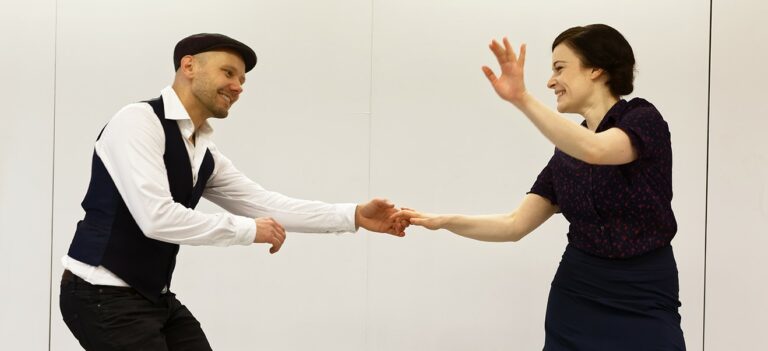Jazz Roots
Solo Dance Classes Celebrating the Spirit of Jazz and Swing
Jazz Roots, also known as Solo Jazz, Authentic Jazz, Vernacular Jazz, or Solo Charleston, is a vibrant and energetic dance form that takes you back to the golden era of jazz and swing music, roughly from the 1920s to the 1940s. These solo dance classes offer a dynamic way to explore the rhythms, movements, and choreographies of iconic jazz dance styles, from the high-energy 1920s Charleston to the sophisticated swing moves of the 1940s big band era. Whether you’re an experienced dancer or just getting started, Jazz Roots is a fun and enriching way to improve your dance skills while diving deep into the rich history of jazz.
What is Jazz Roots?
Jazz Roots refers to a variety of solo dance styles that emerged alongside the jazz music revolution in the early 20th century. This dance form covers a broad range of movements, from the wild kicks and twists of the Charleston to the more fluid and rhythmic steps of 1940s swing. Characterized by its playfulness and rhythmic complexity, Jazz Roots allows dancers to experiment with both improvised steps and structured choreographies.
Unlike its partner dance counterparts, such as Lindy Hop, Balboa, and Shag, Jazz Roots is danced solo, giving dancers full freedom to explore self-expression, body control, and creativity. Jazz Roots is perfect for dancers looking to improve their improvisational skills, enhance their musicality, and develop a strong connection to the rhythms and beats of jazz music. Many people who practice partner dances find that learning Jazz Roots greatly enhances their coordination, timing, and confidence in any dance setting.

What to Expect in Jazz Roots Classes
In a typical Jazz Roots class, you’ll explore a variety of solo jazz dance styles, ranging from the upbeat 1920s Charleston to the expressive and fluid movements of the 1930s and 1940s jazz. The classes often include:
Choreography and Improvisation: Whether you’re dancing a iconic routine like the Shim Sham, Tranky Doo, and Big Apple or improvising to the beat, this dance style allows you to explore your creativity and develop your own personal flair.
Enhances Partner Dance Skills: While Jazz Roots is a solo dance, it’s closely related to partnered swing dances like Lindy Hop and Balboa. By improving your solo dancing, you’ll also become a more confident and expressive partner dancer.
Rhythm and Musicality: Learn how to connect your movements to the rhythm of jazz and swing music, developing your musicality and timing.
Self-Expression: Jazz Roots encourages freedom of expression and personal interpretation of the music, allowing you to express yourself freely through dance.
Historical Connection: Gain a deeper understanding of the cultural and historical roots of jazz dance, particularly its connection to the African American experience in early 20th-century America.
Whether you’re practicing a pre-choreographed routine or letting loose with improvisation, Jazz Roots is a rewarding and fun way to engage with the timeless energy of jazz music.
The Rich History of Jazz Roots
Jazz Roots is deeply rooted in the African American dance traditions of the late 19th and early 20th centuries. The dance emerged alongside the development of jazz music, particularly in Harlem, New York, which became a hub for jazz culture and innovation. Influenced by a variety of dance forms such as the cakewalk, black bottom, African dance, and tap, Jazz Roots evolved through social and performance dance traditions in nightclubs, theaters, and streets.
As jazz music evolved from ragtime to swing and rhythm’n’blues, so did the dance, which adapted to the changing tempos and rhythms of the music. The Charleston of the 1920s, for example, was fast and energetic, reflecting the upbeat nature of the music, while the swing dances of the 1930s and 1940s allowed for smoother, more relaxed movements.
Jazz Roots continues to be celebrated and practiced today as a connection to this rich cultural heritage, honoring the artistic contributions of African American communities during the jazz era.

Join Jazz Roots Classes
If you’re looking for a fun, energetic, and expressive way to improve your dancing, Jazz Roots classes are the perfect fit. In these solo dance lessons, you’ll learn the classic solo jazz movements of jazz and swing music. Dance classes often include both choreographed routines and opportunities for improvisation, giving you the tools to develop your own unique dance style.
Whether you’re a beginner looking for a fun introduction to jazz dance or an experienced dancer wanting to refine your technique, Jazz Roots offers something for everyone. It’s a great way to connect with the history of jazz music, improve your rhythm and body control, and most importantly—have fun! Start dancing Jazz Roots today and step into the joyful world of solo jazz!
Jazz roots classes are solo dance lessons that teach the movements and choreographies typical of the beat of jazz and swing music roughly from the 1920s to the 1940s.
The dance covers a variety of styles ranging from 1920s Charleston and flapper style to 1940s big band swing. Rhythm and play are especially characteristic, and the dance can be free and improvised or ready-made choreographies. Jazz roots is specifically a solo dance, but similar forms of partner dancing at the same time include Lindy hop, Balboa and Shag. Jazz roots is a great dance for those who want to develop body control, choreographic memory, self-expression and improvisation, all of which are also useful in partner dances. The dance is also called solo jazz, Authentic jazz, Vernacular jazz and solo Charleston.
The history of Jazz Roots extends to the black population of the late 19th and early 20th centuries in the United States, and especially to Harlem in New York. As a dance, jazz roots have evolved side by side with jazz music. The development of the dance has been influenced by several dances, such as cakewalk, black bottom, African dances and steppe.











